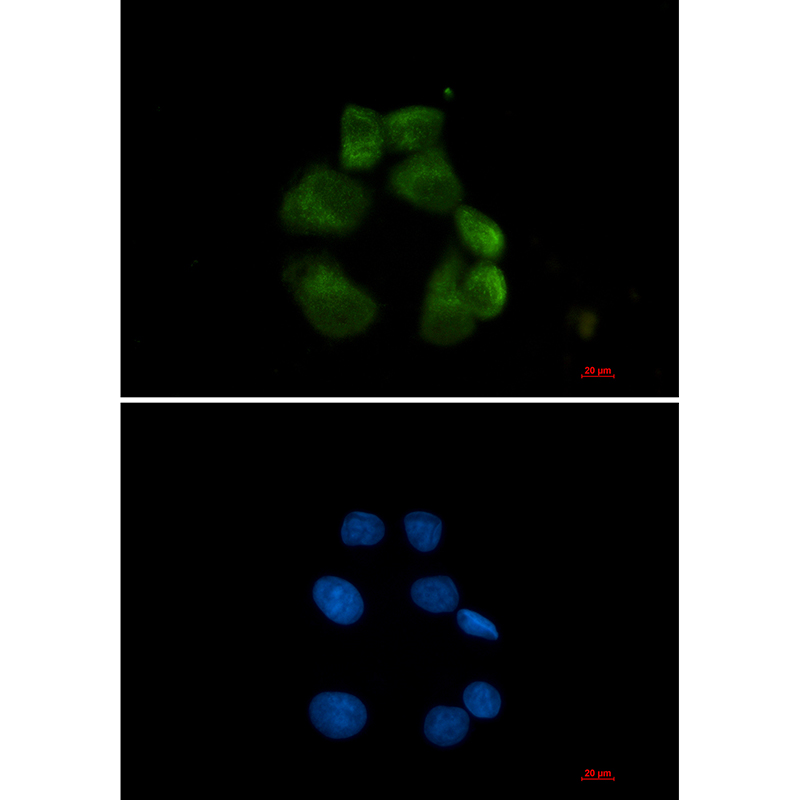USP13 Rabbit mAb
- 产品详情
- 实验流程
Application
| WB, IP, ICC |
|---|---|
| Primary Accession | Q92995 |
| Host | Rabbit |
| Clonality | Monoclonal Antibody |
| Calculated MW | 97327 Da |
| Gene ID | 8975 |
|---|---|
| Other Names | USP13 |
| Dilution | WB~~1/500-1/1000 IP~~N/A ICC~~N/A |
| Format | 50mM Tris-Glycine(pH 7.4), 0.15M NaCl, 40%Glycerol, 0.01% sodium azide and 0.05% BSA. |
| Storage | Store at 4°C short term. Aliquot and store at -20°C long term. Avoid freeze/thaw cycles. |
| Name | USP13 |
|---|---|
| Synonyms | ISOT3 |
| Function | Deubiquitinase that mediates deubiquitination of target proteins such as BECN1, MITF, SKP2 and USP10 and is involved in various processes such as autophagy, endoplasmic reticulum-associated degradation (ERAD), cell cycle progression or DNA damage response (PubMed:21571647, PubMed:32772043, PubMed:33592542). Component of a regulatory loop that controls autophagy and p53/TP53 levels: mediates deubiquitination of BECN1, a key regulator of autophagy, leading to stabilize the PIK3C3/VPS34-containing complexes. Alternatively, forms with NEDD4 a deubiquitination complex, which subsequently stabilizes VPS34 to promote autophagy (PubMed:32101753). Also deubiquitinates USP10, an essential regulator of p53/TP53 stability. In turn, PIK3C3/VPS34-containing complexes regulate USP13 stability, suggesting the existence of a regulatory system by which PIK3C3/VPS34-containing complexes regulate p53/TP53 protein levels via USP10 and USP13. Recruited by nuclear UFD1 and mediates deubiquitination of SKP2, thereby regulating endoplasmic reticulum-associated degradation (ERAD). Also regulates ERAD through the deubiquitination of UBL4A a component of the BAG6/BAT3 complex. Mediates stabilization of SIAH2 independently of deubiquitinase activity: binds ubiquitinated SIAH2 and acts by impairing SIAH2 autoubiquitination. Regulates the cell cycle progression by stabilizing cell cycle proteins such as SKP2 and AURKB (PubMed:32772043). In addition, plays an important role in maintaining genomic stability and in DNA replication checkpoint activation via regulation of RAP80 and TOPBP1 (PubMed:33592542). Deubiquitinates the multifunctional protein HMGB1 and subsequently drives its nucleocytoplasmic localization and its secretion (PubMed:36585612). Positively regulates type I and type II interferon signalings by deubiquitinating STAT1 but negatively regulates antiviral response by deubiquitinating STING1 (PubMed:23940278, PubMed:28534493). |
| Cellular Location | Cytoplasm. |
| Tissue Location | Highly expressed in ovary and testes. |
Research Areas
For Research Use Only. Not For Use In Diagnostic Procedures.
Application Protocols
Provided below are standard protocols that you may find useful for product applications.
终于等到您。ABCEPTA(百远生物)抗体产品。
点击下方“我要评价 ”按钮提交您的反馈信息,您的反馈和评价是我们最宝贵的财富之一,
我们将在1-3个工作日内处理您的反馈信息。
如有疑问,联系:0512-88856768 tech-china@abcepta.com.
¥ 1,500.00
Cat# AP76234























 癌症的基本特征包括细胞增殖、血管生成、迁移、凋亡逃避机制和细胞永生等。找到癌症发生过程中这些通路的关键标记物和对应的抗体用于检测至关重要。
癌症的基本特征包括细胞增殖、血管生成、迁移、凋亡逃避机制和细胞永生等。找到癌症发生过程中这些通路的关键标记物和对应的抗体用于检测至关重要。 为您推荐一个泛素化位点预测神器——泛素化分析工具,可以为您的蛋白的泛素化位点作出预测和评分。
为您推荐一个泛素化位点预测神器——泛素化分析工具,可以为您的蛋白的泛素化位点作出预测和评分。 细胞自噬受体图形绘图工具为你的蛋白的细胞受体结合位点作出预测和评分,识别结合到自噬通路中的蛋白是非常重要的,便于让我们理解自噬在正常生理、病理过程中的作用,如发育、细胞分化、神经退化性疾病、压力条件下、感染和癌症。
细胞自噬受体图形绘图工具为你的蛋白的细胞受体结合位点作出预测和评分,识别结合到自噬通路中的蛋白是非常重要的,便于让我们理解自噬在正常生理、病理过程中的作用,如发育、细胞分化、神经退化性疾病、压力条件下、感染和癌症。







